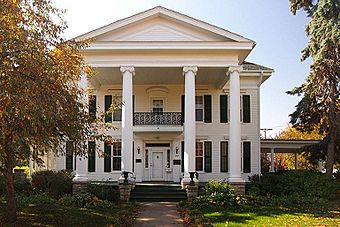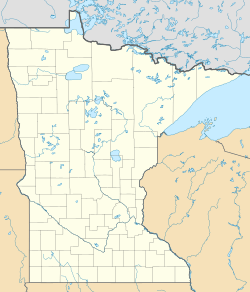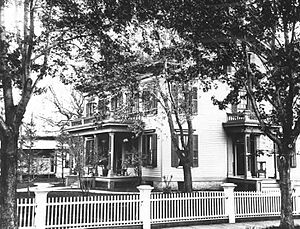Williamson–Russell–Rahilly House facts for kids
Quick facts for kids |
|
|
Williamson-Russell-Rahilly House
|
|

The Williamson–Russell–Rahilly House from the northeast
|
|
| Location | 304 Oak Street, Lake City, Minnesota |
|---|---|
| Area | Less than one acre |
| Built | c. 1868, remodeled 1910 |
| Built by | John Stout (1868), Charles A. Koch (1910) |
| Architectural style | Greek Revival/Neoclassical |
| NRHP reference No. | 84001709 |
| Designated | March 8, 1984 |
The Williamson–Russell–Rahilly House is a special old house in Lake City, Minnesota. It was first built around 1868 in a style called Greek Revival. Later, in 1910, it was updated to a new look called Neoclassical. This house is so important for its beautiful design that it was added to the National Register of Historic Places in 1984. It's a great example of fancy homes from the early 1900s in Minnesota.
Contents
What Does the House Look Like?
Original Design (1868)
The main part of the Williamson–Russell–Rahilly House has two floors. It was built using a wood frame. The front of the house is very balanced, with the main door right in the middle. On each side of the door, there are columns that look like they are part of the wall. Both floors have windows with decorative frames above them. The sides of the house have pointed roofs, which are a classic part of the Greek Revival style. Back then, there were also small porches over the front and side doors.
Changes in 1910
In 1910, the house got a big makeover! The old porches were removed. A large, two-story porch was added to the front. This new porch has a triangular roof supported by four tall, fancy columns. The side entrance got a special covered driveway called a porte-cochère, where people could drive their carriages or cars right up to the door. A screened-in porch was also added to one side.
Above the front door, there's a small balcony with a cool metal railing. This railing has a star design called Étoile du Nord, which means "Star of the North." It used to be on another famous house, the Alexander Ramsey House in Saint Paul, Minnesota. A new section was also built at the back of the house.
Who Lived in This Historic House?
Early Owners and Builders
The very first house on this spot was built in 1855 for Samuel Doughty. He was one of the people who helped start Lake City. Two years later, he sold the house to Harvey Williamson. Harvey was the first postmaster in Lake City. Sadly, the house burned down in 1868. Harvey then hired a carpenter named John Stout to rebuild it on the same foundation.
Harvey Williamson and his family lived in the new house until 1882. Then, they sold it to Morris C. Russell. Morris was the editor of Lake City's first newspaper. He had a tough start, arriving in Minnesota as a 14-year-old orphan. He even worked as a scout during the Dakota War of 1862. In 1881, he moved to Lake City and started his newspaper, the Graph-Sentinel.
The Buck Family
Morris Russell didn't own the house for long. By 1882, tax records show it belonged to Lyman and Melissa Buck. They owned a store together that sold things like fabric and household goods. After Lyman passed away in 1890, Melissa kept the business going. She likely died around 1900, because that's when her daughter sold the house to its next owner, Patrick Henry Rahilly.
Patrick Henry Rahilly's Time
Patrick Henry Rahilly was a very important farmer and politician. He was born in Ireland in 1832 and moved to the United States with his family in 1849. He came to Minnesota in the 1850s. In 1868, he started a farm near Lake City. Six years later, he got involved in politics. He was elected to the Minnesota House of Representatives three times and also served in the state senate. His old farmhouse, built in 1880, is also a historic landmark!
Around 1900, Patrick Rahilly bought the Williamson–Russell House. He used it as a place to stay when he was in town. In 1910, his wife passed away. This led him to sell his farm to his daughter and her husband. He then moved into the Lake City house permanently.
That same year, Patrick Rahilly hired Charles A. Koch, a local architect, to update the house. Charles Koch changed the Greek Revival house into the grand Neoclassical mansion we see today. Patrick Rahilly lived in the house until he passed away on January 12, 1931, at 98 years old. The Rahilly family kept the house as a summer home until 1963. Then, George W. Enz, a singer who performed in the famous Ziegfeld Follies, bought it.
Images for kids





